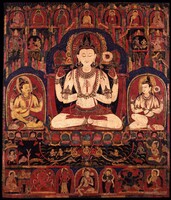 This seven painting set of Shakyamuni Buddha and the Sixteen Arhats is missing painting numbered 'Left One' containing four of the arhats. (See the Outline Page for this painting set).
This seven painting set of Shakyamuni Buddha and the Sixteen Arhats is missing painting numbered 'Left One' containing four of the arhats. (See the Outline Page for this painting set).
One of the most interesting things about this set from the The Field Museum in Chicago is the depiction of a single Tibetan Lama bearing the inscription Je Changkya Rinpoche. From the incarnation line of the Changkya Tulkus it is quite possible that this is referring to Changkya Rolpai Dorje (1717-1786) an extremely important figure for Buddhism in China in the 18th century. (See the upper right corner of HAR #54439 for Changkya Rinpoche).
In Tibetan painting and sculptural sets the arhats are never created alone as just a set of sixteen. The full composition always has twenty-five figures: the most important - Buddha Shakyamuni, together with the two foremost disciples - Shariputra and Maudgalyayana, followed by the sixteen Arhats. Accompanying all of those are the attendant Dharmatala, the patron Hvashang and the Four Guardians of the Directions; Vaishravana, Virupaksha, Dhritarashtra and Virudhaka.
Arhat (Tibetan: ne tan): a Sanskrit term for Buddhist saints representing the earliest followers of the Buddha, always found in a group of sixteen (arhats), they are painted on cloth, as wall murals, and fashioned of metal, stone, clay, or wood. An early iconographic source for the individual descriptions of the arhats is the verse text Praise to the Sixteen Arhats attributed to the Kashmiri teacher Shakyashri Bhadra of the 12th/13th century.
In all, an extensive set of paintings with one figure per composition would comprise twenty-three individual paintings making up the complete work. In painting the two foremost disciples are almost always portrayed in the same composition with Buddha Shakyamuni. Each of the other figures is depicted in their own individual composition. In Chinese Buddhist art they count eighteen arhats known as lohan. This number is calculated by adding Dharmatala and Hvashang and including them as arhats (lohan) whereas the Tibetan system does not.
 Shakyamuni Buddha and the Sixteen Arhats are the most common painting subject found in Himalayan art. The Buddha and arhats can be depicted all together in one composition or spread over several compositions of three, five, seven, eleven or twenty-three paintings in total. The complete complement of figures in a set is twenty-five. (See the Arhats Painting Sets Outline).
Shakyamuni Buddha and the Sixteen Arhats are the most common painting subject found in Himalayan art. The Buddha and arhats can be depicted all together in one composition or spread over several compositions of three, five, seven, eleven or twenty-three paintings in total. The complete complement of figures in a set is twenty-five. (See the Arhats Painting Sets Outline).















